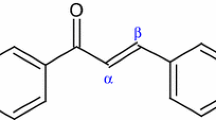Abstract
In this article, we report herein the SAR studies of a series of (1H-indol-3-yl)alkyl-3-(1H-indol-3-yl)propanamide 10(a–j), 11(a–j). The synthesized compounds were evaluated for their preliminary in vitro antibacterial, antifungal activity and were screened for antitubercular activity against Mycobacterium tuberculosis H37Rv strain. The synthesized compounds displayed interesting antimicrobial activity.




Similar content being viewed by others
References
Barry AL (1980) Procedure for testing antimicrobial agents in agar media. In: Corian VL (ed) Antibiotics in laboratory medicine. Williams and Wilkins, Baltimore, pp 1–23
Chan LC, Cox BG (2007) Kinetics of amide formation through carbodiimide/N-hydroxybenzotriazole (HOBt) couplings. J Org Chem 72:8863–8869
Charansingh G, Ganesh J, Mohammad S, Rajesh K, Anant G, Deepak N, Mahendra S (2008) Clubbed [1,2,3] triazoles by fluorine benzimidazole: a novel approach to H37Rv inhibitors as a potential treatment for tuberculosis. Bioorg Med Chem Lett 18:6244–6247
Corbett EL (2003) The growing burden of tuberculosis, global trends and interactions with the HIV epidemic. Arch Intern Med 163:1009–1021
Dixit PP, Vijaykumar JP, Prathap SN, Sanjay J, Neelima S, Sudershan KA (2006) Synthesis of 1-[3-(4-benzotriazol-1/2-yl-3-fluoro-phenyl)-2-oxo-oxazolidin-5-ylmethyl]-3-substituted-thiourea derivatives as antituberculosis agents. Eur J Med Chem 41:423–428
Gribble GW (2000) recent developments in indole ring synthesis-methodology and applications. J Chem Soc Perkin Trans 1:1045–1075
Hibino S, Choshi T (2002) Simple indole alkaloids and those with a nonrearranged monoterpenoid unit. Nat Prod Rep 19:148–180
Horton DA, Bourne GT, Smythe ML (2003) The combinatorial synthesis of bicyclic privileged structures or privileged substructures. Chem Rev 103:893–930
Humphrey GR, Kuethe TJ (2006) Practical methodologies for the synthesis of indoles. Chem Rev 106:2875–2911
Jyoti P, Vinod KT, Shyam SV, Vinita C, Bhatnagar S, Sinha S, Gaikwad AN, Rama PT (2009) Synthesis and antitubercular screening of imidazole derivatives. Eur J Med Chem 44:3350–3355
Leo A, Hansch C, Elkins D (1971) Partition coefficients and their uses. Chem Rev 71:525–616
Mariangela B, Giulio CP, Giovanna P, De Alessandro L, Rita M, De. Edda R, Fabrizio M, Maurizio B (2009) 1,5-Diaryl-2-ethyl pyrrole derivatives as antimycobacterial agents: design, synthesis, and microbiological evaluation. Eur J Med Chem 44:4734–4738
Nakayama H, Ishihara K, Uenishi J, Akiba S (2011) Synthesis of N-[2-(2,4-difluorophenoxy)trifluoromethyl-3-pyridyl]sulfonamides and their inhibitory activities against secretory phospholipase. Chem Pharm Bull 59:1069–1072
Neetu KT, Jaya ST (2007) Resazurin reduction assays for screening of anti-tubercular compounds against dormant and actively growing Mycobacterium tuberculosis, Mycobacterium bovis BCG and Mycobacterium smegmatis. J Antimicrob Chemother 60:288–293
Pindur U, Adam R (1998) Synthetically attractive indolization processes and newer methods for the preparation of selectively substituted indoles. J Heterocycl Chem 25:1–8
Ranjith PK, Siji M, Divia N, Haridas KR (2010) Tetra butyl ammonium chloride catalyzed synthesis of substituted benzimidazoles under microwave conditions. J Korean Chem Soc 54:589–593
Ranjith PK, Haridas KR, Susanta KN, Row TNG, Rajeesh P, Rishikesan R, Suchetha NK (2012) Design, synthesis of some new (2-aminothiazol-4-yl)methylester derivatives as possible antimicrobial and antitubercular agents. Eur J Med Chem 49:172–182
Siu J, Baxendale IR, Ley SV (2004) Microwave assisted Leimgruber–Batcho reaction for the preparation of indoles, azaindoles and pyrroylquinolines. Org Biomol Chem 45:160–167
Subramanian VK, Subbu P, Krithika AS, Perumal Y, Dharmarajan S (2009) A microwave-assisted facile regioselective Fischer indole synthesis and antitubercular evaluation of novel 2-aryl-3,4-dihydro-2H-thieno[3,2-b]indoles. Bioorg Med Chem Lett 19:3006–3009
Tangallapally RP, Yendapally R, Lee RE, Hevener K, Jones VC, Lenaerts AJM, McNeil MR, Wang Y, Franzblau S, Lee RE (2004) Synthesis and evaluations of nitrofuranylamides as novel antituberculosis agents. J Med Chem 47:5276–5283
Tois T, Franzen R, Kiskinen A (2003) Synthetic approaches towards indoles on solid phase recent advances and future directions. Tetrahedron 59:5395–5405
Verma RS, Khan ZK, Sing AP (eds) (1998) Antifungal agents: past, present and future prospects. National Academy of Chemistry and biology, Lucknow, pp 55–128
Acknowledgments
Authors are thankful to Head of the Department of Biochemistry, Justice K. S. Hegde Medical Academy, to carry out biological studies. They are also grateful to the Head, Chemistry Department and School of Chemical Sciences for providing necessary laboratory facilities for the research work and valuable support.
Author information
Authors and Affiliations
Corresponding author
Rights and permissions
About this article
Cite this article
Karuvalam, R.P., Pakkath, R., Haridas, K.R. et al. Synthesis, characterization, and SAR studies of new (1H-indol-3-yl)alkyl-3-(1H-indol-3-yl)propanamide derivatives as possible antimicrobial and antitubercular agents. Med Chem Res 22, 4437–4454 (2013). https://doi.org/10.1007/s00044-012-0451-x
Received:
Accepted:
Published:
Issue Date:
DOI: https://doi.org/10.1007/s00044-012-0451-x




